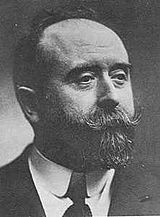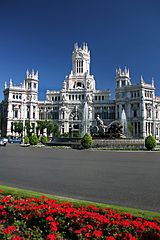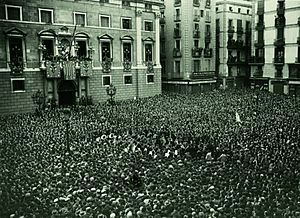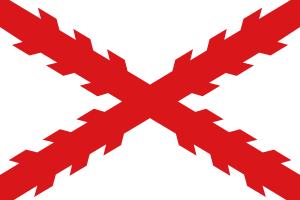Jaime Chicharro Sánchez-Guió facts for kids
Quick facts for kids
Jaime Chicharro Sánchez-Guió
|
|
|---|---|
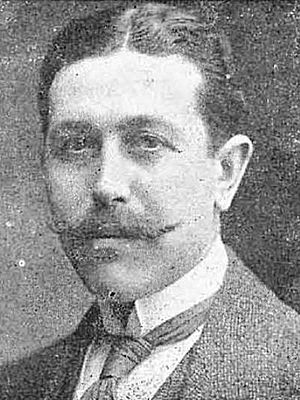 |
|
| Born |
Jaime Chicharro Sánchez-Guió
1889 Torralba de Calatrava, Spain
|
| Died | 1934 (aged 44–45) Guadarrama, Spain
|
| Nationality | Spanish |
| Occupation | lawyer, landowner |
| Known for | Politician |
| Political party |
|
| Spouse(s) | Dolores Lamamié de Clairac Romero y Bermúdez de Castro (1890-1974) |
| Children | 13 |
Jaime Chicharro Sánchez-Guió (1889–1934) was a Spanish politician. He was part of the Conservative Party and later the Carlist movement. He is best known for helping to transform a fishing bay in Burriana into a modern port. This port made it much easier to export oranges grown in the area. As a politician, he represented large landowners within the Carlist movement.
Contents
Early Life and Family
Jaime Chicharro Sánchez-Guió was born into a family of landowners in Castile, Spain. His family came from the Basque Country. His grandfather, Jesús Chicharro de la Torre, was a military engineer. He settled in the province of Ciudad Real after working on railway construction.
Jaime's father, José Chicharro Martín del Moral (1856-1905), supported the Carlists during the Third Carlist War. He married Soledad Sánchez-Guió Ruiz-Hidalgo (1860-1912). They had four children, including Jaime and three daughters. The family was very religious and raised their children in a strong Catholic environment.
In 1897, young Jaime started school at the Jesuit Colegio Nuestra Señora del Recuerdo in Madrid. After finishing high school, he moved to Biscay. He began studying law at the Jesuit Deusto College. After graduating, he also earned a diploma in Philosophy and Letters from the Universidad Central in Madrid. With two degrees, he settled in Madrid and became a history teacher at the same Jesuit college he had attended.
In 1912, Chicharro married Dolores Lamamié de Clairac Romero y Bermúdez de Castro (1890-1974). She was related to a well-known Carlist politician and landowner from Salamanca, José María Lamamié de Clairac. Dolores inherited about 300 hectares of land near Villarreal and Nules. Because of this, the family moved to her estate, La Salmantina, which is now in the municipality of Les Alqueries in Castellón province.
Jaime and Dolores had 13 children between 1914 and 1932. During the early months of the Spanish Civil War, their oldest daughter died in Madrid. Five of their sons joined the Carlist Requeté (a Carlist militia). One of them died in 1939 due to injuries suffered as a prisoner of war. Four sons joined the División Azul (a Spanish volunteer division that fought in World War II). Two of them died fighting in Russia. The two who survived became generals in the Francoist army. His second youngest son worked as a diplomat. The youngest son became famous as a wrestling champion in the 1950s.
Joining the Carlist Movement
Jaime Chicharro inherited his strong conservative views from his father. His father wrote articles for a Carlist newspaper in the 1880s. Jaime's beliefs became even stronger during his university years in Madrid. He met and was greatly influenced by Juan Vázquez de Mella, a leading Carlist thinker.
In 1909, Chicharro helped start a local Carlist center called Centro Tradicionalista. With other young Carlists, he created a review called El Combate, which was later renamed Juventud Tradicionalista. He was also active in Catholic organizations. He spoke at public meetings, for example, against the idea of non-religious education. In 1911, he helped launch the Congreso Eucaristico and joined the Junta Nacional de Propagandistas de Acción Católica. Also in 1911, Chicharro joined the Madrid Junta Católica, which was part of a national effort by the Church to form a large Catholic political alliance. By this time, he was already a nationally recognized Carlist activist.
When Chicharro moved to Castellón province after his marriage, he continued his political activities. He became president of the local Juventud Jaimista (Young Carlists) and, in 1915, became the leader of the Villarreal Jaimistas. In 1916, he joined the Castellón Provincial Board and became its vice-president, while still leading the Villarreal group. That same year, he ran for the Cortes (Spanish Parliament) for the first time in the Nules district.
At that time, Carlism in Valencia was divided. Chicharro seemed to avoid these divisions and ran on a broad conservative platform. He was loyal to the party leader from Murcia, Juan de la Cierva y Peñafiel.
He tried again in Nules in the 1918 election. Some say he was criticized by strict Carlists because he preferred wide-ranging Right-wing alliances, which blurred the Traditionalist identity. He lost again. He also failed to win in a special election held later that year after the winning candidate died.
A Mellista Politician
In the 1910s, the Carlist movement was increasingly split between its main thinker, Juan Vazquez de Mella, and the Carlist claimant to the throne, Jaime III. Mella focused less on who should be king and more on creating a large Right-wing group based on Traditionalist values. Chicharro supported his former teacher, Mella, and became one of his strongest followers. When the conflict grew in 1919, and Carlists had to choose sides, Chicharro left the claimant and joined Mella's group.
In the 1919 election campaign, Chicharro ran on a broad conservative platform. He supported the idea of a large Catholic national party of the Right. Some sources say he was a government candidate, while others describe him as a Catholic-monarchist or a Carlist. He finally won and, in the Cortes, he sided with the ciervistas (followers of Juan de la Cierva). In the 1920 re-election campaign, loyal Carlists opposed him, but he managed to win again. He served in parliament until 1923.
In parliament, which was mostly controlled by the Conservatives of Eduardo Dato, Chicharro was a very active and sometimes rebellious deputy. He often spoke out against liberal ideas. He was especially vocal about money matters, getting into arguments about taxes and the budget with the Minister of Economy.
His most important achievement was a Royal Order that provided significant government money for developing the local Burriana harbor. This plan included a major upgrade of the port facilities and new investments to connect the port to the national railroad network. The work continued until the early 1930s. It turned what was once a simple fishing bay into a small but modern commercial port. The main beneficiaries were the local landowners in Levante, who gained a way to export their oranges. Chicharro continued to support their cause in Madrid for many years. In recognition of his efforts, the city of Burriana named Chicharro its "hijo adoptivo" (adopted son). When he returned from Madrid, he was welcomed with celebrations.
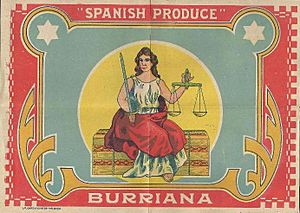
Even though he was a strong supporter of de Mella, Chicharro did not fully join the Mellista group. Some people even spoke of "chicharrismo," while others called him "mauro-ciervista." While de Mella stuck to his Traditionalist principles, Chicharro started to favor Victor Pradera's idea of a looser Right-wing alliance. In the early 1920s, he left the Mellistas. Some historians see him as an example of many rebellious Carlists who joined de Mella in 1919 but soon left to pursue their own goals and join other Right-wing groups.
A Catholic Conservative Leader
During the 1923 election campaign, Chicharro was expected to win. It's not clear how much he hurt his own chances. During one election meeting in Burriana, he got into a fight with a local workers' leader. Chicharro used a stick, and his victim had to be treated in the hospital for head wounds. An official action was taken against Chicharro. The newspaper he founded and owned, Diario de Castellón, did not gather enough support and caused significant financial losses. In the end, Chicharro and another candidate had almost the same number of votes. The other candidate was declared the winner after some behind-the-scenes negotiations.
In 1924, Chicharro helped set up the local Castellon branch of the Union Patriotica. He soon became its provincial leader. In this new single party, he supported the Catholic branch. He felt increasingly sidelined as Catholic groups were marginalized. Other local members accused him of building the local party mainly around his former Traditionalist supporters. This conflict reached its peak in 1925 when Chicharro resigned from the provincial presidency in protest.
In 1925, the Chicharro family left Levante and moved to Madrid. It is not clear if this move was due to political tensions or financial issues, as some sources suggest. In Madrid, he began working as a lawyer and became quite successful. In the early 1930s, he became a member of the Governing Board of the Madrid Lawyers' Association.
In 1927, Chicharro started his career as a city official. He was appointed one of 64 new councilors of the Madrid ayuntamiento (city council). In 1928, he became a deputy mayor (teniente de alcalde) responsible for the Chamberí district. He was appointed a member of the Junta municipal de Primera enseñanza, specializing in education issues and also dealing with culture and science. Chicharro reconnected with Vázquez de Mella. Just weeks after Mella's death in March 1928, Chicharro arranged for a memorial plaque to be placed on a school wall and took care of Mella's library. By 1930, the press referred to him as a former deputy mayor, but it's not clear when he left the position.
During the last years of the monarchy, Chicharro seemed unsure about his political path. Although a newspaper poll voted him one of the three best representatives of Castellon province in the National Consultative Assembly, he was not appointed a member. He remained active in Catholic groups like Acción Social, giving lectures and helping to organize events. As a friend of Lamamié, he kept ties with his Acción Castellana, formed in 1930. He was also drawn closer to another of Lamamié's organizations, the Federación Católico-Agraria Salmantina. He remained in the circle of Francesc Cambó, leader of the Catalan conservative Lliga Regionalista. He also kept his Carlist contacts with the former mellistas, now led by Victor Pradera.
Returning to Carlism
During the local elections in April 1931, Chicharro was defeated by the rising republican movement. As an independent conservative candidate, he failed to be elected to the Madrid city council. After the Republic was declared, he decided to run in the June 1931 elections for the Cortes from Castellón. He was still supported by Diario de Castellón, which was the official voice of the Federación Castellonense de Sindicatos Agrícolas. Chicharro was invited to join the Republicans. According to one source, he bravely refused, but the press reported him as running as a "derecha republicana" (republican right-winger). The result was poor; he came 11th with about 11,000 votes out of 96,000 cast in the province.
In late 1931, Chicharro began attending Traditionalist meetings. He gradually rejoined the followers of the Carlist king and became part of their new organization, Comunión Tradicionalista. Although not a national leader, he became one of the most quoted Carlist speakers in the first half of 1932. He was very active, traveling the country and giving public speeches. In January 1932, he gave a lecture about cooperation and Carlism. In February, he presented a broad foreign policy plan that included controlling Gibraltar, forming a federation with Portugal, and a confederation with Latin American states. In March, he called universal suffrage unfair and criticized the Republican government for overspending. The same month, he caused riots in Soria by stating he would not give up any of his wealth without a fight. In April, his car was stolen from a Madrid street. Several meetings he attended were stopped due to fears of unrest. In late 1932, he started writing newspaper articles himself.
In 1932, Chicharro was involved in a conspiracy led by José Sanjurjo, though details are not known. After the failed coup, he was identified as one of the people responsible. His property became subject to expropriation, a process designed to support the struggling Agrarian Reform. Later that year, two of his sons were arrested and sent into exile in Villa Cisneros in the Spanish Sahara. This place would soon become a center for Carlist activity. Continuing his tours across the country in 1933, he defended some of the Sanjuriada conspirators in court. However, he was closely watched by security forces and faced trial in May for inflammatory speeches.
Final Months
In 1933, Chicharro was active in the Tradicionalistas y Renovación Española alliance, which included Alfonsist monarchists. The local Castellon Liaison Committee agreed that he would represent them in the upcoming elections. This made him unpopular among new, radical Carlist activists like Jaime del Burgo. These activists disliked working with old political bosses and remnants of the Alfonsine monarchy. For the Carlist youth, landowners like Lamamié and Chicharro were seen as privileged figures who were "obstructing the Agrarian Reform by the feudal egoism of the odious grandees of grain."
Although Chicharro represented a very conservative part of Carlism, he was not against new radical social movements. When discussing Benito Mussolini and Adolf Hitler, he stated that Traditionalism, "though not one and the same thing, is very sympathetic towards them." He believed they were fighting against Judaism, freemasonry, and Marxism, and building an organized corporate state. He added, "What is unacceptable to us is the state's overwhelming power. For us, the family comes first, followed by the municipality, region, and state, which is the last element in this chain."
Riding a wave of increasing support for right-wing groups, Chicharro was elected to the Madrid city council from the Chamberí district in 1933. However, when running on the Carlist ticket for the Cortes from Castellón, he narrowly lost. Although the press initially reported him as victorious, his fellow Traditionalist Juan Granell Pascual was indeed elected.
By this time, he was already seriously ill. He had generally poor health, and as a chain-smoker, Chicharro developed severe breathing problems. Although the press still called him an "ilustrado joven" (enlightened young man) as late as 1932, in August 1933 he was admitted to the tuberculosis-treatment Real Sanatorio de Guadarrama. He died there in early 1934. His funeral and memorial events held across Spain helped to gather support and showed the growing strength of Carlism. Since his widow and 13 children were facing financial difficulties, the Comunión Tradicionalista launched a public fundraising campaign to help them.
See also
 In Spanish: Jaime Chicharro para niños
In Spanish: Jaime Chicharro para niños
- Carlism
- Mellismo
- José María Lamamié de Clairac
- Juan Vázquez de Mella
- Restoration (Spain)
- Miguel Primo de Rivera
- Second Spanish Republic
- Port of Burriana




